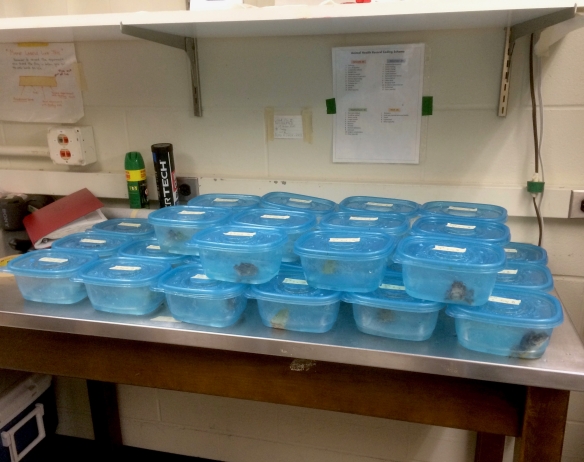Frog season is upon us, and for us in the Frog Lab, regular sleeping hours are a luxury of the past. In the day we hide from the sun in basements and prepare our equipment.

Painting frog models to perfectly match real frogs.

Calibrating a speaker so that it ouputs the sound of a frog call at exactly 85.0 dB.
In the night, we don our chest waders, take up our headlamps, hang bags of tupperware from our wader straps, and walk into the ponds to seek our prey.

The ponds are black water with algae, duckweed, grasses, and reeds conspiring to make them more a vegetation soup than a body of water. The grasses catch at your boots, and when you walk near reeds, you acquire a raft of floating dead reeds about your middle. Mud tries to suck you down and you must learn to distribute your weight evenly and not stand too long in any soft place.
The pond is alive with motion and the shining spots of reflective eyes. Leeches and other wormy lifeforms wriggle and glide just under the water’s surface. Spiders of some gray, gracefully-proportioned species hunt on the vegetation at the surface, fleeing you when you walk past, their eyes reflecting a particular gold-green hue that lets you estimate their vast numbers from the constellations glittering on the pond all around you. Tiny beetles dart about through the water, their reflective carapaces making them look like polished metal beads.
And of course, the reason you are there: the frogs. You seek Hyla chrysoscelis, Cope’s gray treefrog, a moderately-sized frog with large black eyes and skin that in the warmth of the night is usually green, sometimes mottled gray. But there are other frogs about too, all the single males calling for their mates, and the din is loud enough to hurt your ears. Tiny, striped chorus frogs have a call like a musical comb, except not very musical, just a quick, repeated racket much too loud for such a small beast. Their eyes are golden pinpoints, almost as small as the spiders’. American toads sound much like your target treefrogs, a flat, rapidly-pulsing statement, except that where your treefrogs’ call lasts a second, the toads’ just keeps on and on. The toads sit in loose groups, as straight upright as a toad can get, as if they are all attending an important meeting.
Your treefrogs blend into the general green, but the single males are not too hard to spot, sitting fairly upright to keep their pulsing throat sacs out of the water, and thereby baring white bellies.
But you don’t want these hopeful males. You want females, whose preferences for calls you will study, and the females are elusive to the point of invisibility. The single females must be in the pond, listening to the males and deciding whose call is best, but you will never see them. The only way to find an interested female is to find her after she has made her decision, when she sits in the pond with her chosen male clinging to her back in the amphibian hug called amplexus.

Amplexus may look like mating to our human preconceptions, but it is only the prelude to that. These paired females are fertile and interested in male calls: they are our targets. You might expect that identifying frog entities with two heads would be easy, but these pairs sit low in the water, white bellies hidden, the female’s head nearly hidden too, their mottled green blending into the algae. Catching them is hard; finding them at all is harder.
We stalk the pond until the night’s chorus begins to fade as the air chills, somewhere around midnight. We return to our lab with our tupperware full of prizes.

(Don’t worry, they have air holes.)



These frogs will be our guests for a day or three, the females hopping along in our behavioral preference tests, the males calling hopefully and then clasping the females again when we return them.


Then we drive the frogs back to their pond and release them, and we wade back out to seek more.

Hi Katie! What a wonderful article!
Can I see the finished painted frog models?